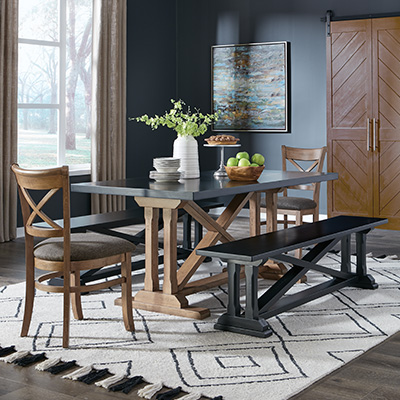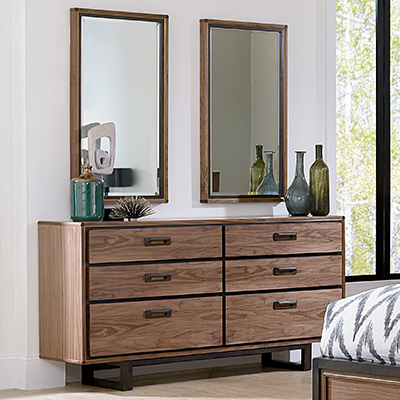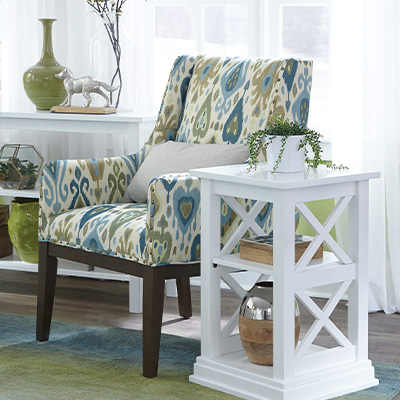Design Tips
1. Determine Your Style
How do you want your space to feel? Here’s a sure-fire trick to get you in the right direction.
Create an interior design mood board, and most importantly—have fun with it. This is not the time to overthink it. Visit a store with a great magazine selection and grab up a bunch of “home” magazines. Take pictures of the looks you love, or even like. If there’s a magazine that you like several looks, buy it so that you can pull-out the pages. Go home and print out your pictures, or pull-out the pages and glue them onto a poster board. This doesn’t have to be art. It’s more about a process of starting to realize a pattern of what you’re drawn to.
2. Figure Out What You Don’t Like
Most of the time it’s easier to express what you do like, when you’ve determined what you don’t like.
For example, a bold large-scale print might remind you of something in your childhood that you don’t want to see in your own space. Or a wingback chair might bring back memories of being sent to time-outs. Likewise, a certain color might evoke feelings of a past design trend that you disliked. Memories and reactions are personal and individual. They define our tastes, so hone in on what you don’t like, as well as what you do.

3. Make Wall Art Your First Consideration
Many times we make wall art our last, or secondary consideration when it can make the entire process, starting at A and eventually getting to Z, a much smoother (and quicker) transition.
Art evokes an immediate reaction of like or dislike and, most importantly, instantly creates a color palette. You can have a room with a beautiful paint color, fabulous furnishings, great lighting and accessories, but nothing will make it feel complete, and pulled together, like art. Simply put – start with art! Source what you like. It doesn’t have to be expensive or grandiose, or even new. Vinyl canvas prints are extremely inexpensive and can add that WOW for a fraction of the cost of finer art. Choose art you love and pull color from it from paint to pillows, to furniture. If you start with art, you’ll almost always land in the design of your dreams.
4. Focus On One Room At a Time
If you’re buying a home for the first time, or making-over your existing home, start and focus on one room at a time.
If you try to focus on the whole home, or even more than one space you’ll often get stuck. Focus on one room, get it where you love it and then go from there.
5. Test Paint
Paint color is one of the most important and cost-effective decisions you make.
Color is what harmoniously connects spaces and brings them together. Consider the house as a whole and each room flowing from one to the next. Always sample actual paint colors on your walls when making a decision. Observe them in your space at various times of the day and against another color you’re considering. Paint chips are great in the store, but often don’t translate the same way in your actual space.

6. Consider Scale
Often you see furniture that is too large or too small for a space.
Build around the furniture that you actually have space for and remember that balance is paramount. For larger rooms, consider zoning specifically to your lifestyle, ie. a seating area that is intimate for guests; another area for TV chilling; a work area with a desk or table for projects or games. Think about visual weight and distribution to balance out a space.
7. Don’t Be Afraid of Color
Color sets the stage for the space, and is the most inexpensive way to transform a room; you can pack a ton of punch for a minimal cost. It’s also a very doable DIY project, so don’t be afraid to be bold and go for it.
8. Consider Textures and Heights
The most amazingly well thought out spaces fall flat without considering texture and various heights.
Texture adds to a space’s overall appeal and interest. Texture is the magical ingredient that secretly ignites the senses and makes a space pop. It too enforces your style, ie. rustic interiors tend to have more matte finishes and diverse, rough textures, while modern spaces tend to have more high sheen finishes and smoother, luxurious textures. Considering various heights determines the way your eye moves around a space. Incorporating various heights (high, low, eye level) naturally causes your eyes to dance around a room.

9. Make What You Love Work
Have an old chair Grandma passed down to you? A piece of art you picked up while in college?
There are going to be pieces you don’t necessarily see as “fitting” into your design, but if you love them, make room for them. No space is complete without the oddball, thrown in pieces that weren’t perfectly orchestrated for a space. These are your conversation pieces, the pieces that tell a story about where you’ve been and who you are. Maybe that means a chair recover, or a paint job, but incorporating loved pieces picked up from here or there, are what make your space you and unique.
10. What Worked There, Doesn’t Work Here
Unfortunately, when you move from one space to another, what worked there, doesn’t work here. Don’t force it.
If there are pieces you love make them work, but if there are pieces that are obviously too big or too small for your new space, consider replacing them with ones that do naturally fit. Many times we assume that because something worked in one space it’s going to seamlessly translate into another, but most times — simply put — they don’t.
